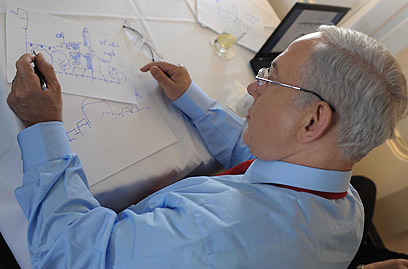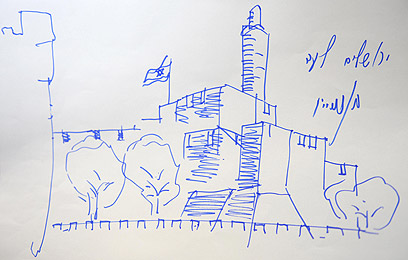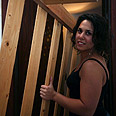"There is something special here that unites people. I wouldn't want to live anywhere else," Inbal Halperin, a 28-year-old master's degree student who works as a developer of communities for young people in the capital, said one the eve of Jerusalem Day, which Israel marks on Sunday.
Halperin returned to Jerusalem two years ago after living in Tel Aviv for three years, but the capital is still plagued by negative migration.
Related articles:
- Muslims revive old pilgrimage route via Jerusalem
- Op-ed: A lesson on Jerusalem
- Op-ed: Jews belong in Jerusalem
To mark Jerusalem Day, the Government Press Office published photos of Prime Minister Benjamin Netanyahu drawing the Old City walls and the Tower of David during a recent flight to Prague. But statistics paint a bleak picture. In 2011 some 10,500 people moved to Jerusalem, while 18,000 left the capital.

PM draws Old City on flight to Prague (Photo: Avi Ohayon, GPO)
Halperin, who was born in Jerusalem, left for Tel Aviv after her army service. "Like everyone else, I wanted a change of atmosphere, but after completing my bachelor's degree I felt something was missing, so I returned to Jerusalem and found a job," she told Ynet. "Besides, the rent here is lower. The apartment I live in would cost double in Tel Aviv.

PM's drawing of Tower of David (Photo: Avi Ohayon, GPO)
"It is true that it is hard to find a job here and that the problem of the expansion of the ultra-Orthodox population also affects apartment prices, but I believe that young secular people, if they work together, can change the situation," she said.
According to Halperin, "There is a different spirit in Jerusalem and different types of people who make the city the real thing. This is the real Israel: Haredim, Arabs, seculars, young people – all living together. Those who want to live in a bubble can find it in Tel Aviv.
"I returned because I wanted to do something that has social significance, and I thought Jerusalem was the right place to do it in. I wanted to live among people who, like me, want to be involved. Tel Aviv is fun, but there is also a sense of alienation. Jerusalem, on the other hand, is a hotbed for young activists," she said.
Of the 801,000 people who currently reside in Jerusalem, 407,000 are Jews (62%), 281,000 are Muslim (35%) and 14,000 are Christian (2%).
Tamar Katzir, 26, left Jerusalem a year ago. "I work in the communications field, and while I knew there were possibilities in Jerusalem, the leading companies are in Tel Aviv. Many of my friends left Jerusalem simply because they did not see a professional future there. This issue is very significant, particularly when you are just out of university and think about what you want to do with your life," she told Ynet.
Addressing the growing haredi population in the capital, Katzir said "this is not an easy city. People sometimes feel like strangers in their own neighborhood and draw conclusions. For me personally – there were not enough pluralistic young people in the city."
Elisheva Mazya, who heads New Spirit, an organization that encourages young adults and professionals to stay in Jerusalem, said "this is the first year in which I am sensing a real change. Serious efforts have been made over the past few years to change the city's image, which is significant in making the city attractive to people. A growing number of young people want to stay here, and a lot of work is being done with regards to housing and employment – which ultimately make the difference."
- Receive Ynetnews updates
directly to your desktop
















